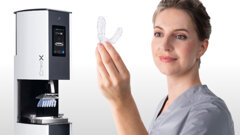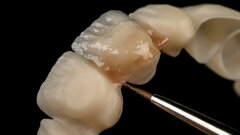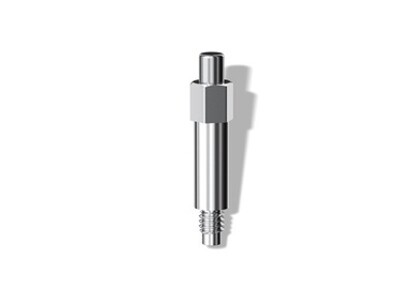The SmartPeg is used together with the measurement instruments Osstell IDx or Osstell ISQ. Both instruments measure the resonance frequency of a SmartPeg, when it is attached to an implant.
The SmartPegs are single use items. To avoid damage to the implant, the SmartPeg material is quite soft, which limits the lifetime of the threads.
Disposable SmartPegs
Osstell SmartPegs are delicate measurement devices. The Osstell ISQ instrument vibrates the SmartPeg through magnetic pulses and measures the resonance frequency of it. In order for the SmartPeg to function properly, it needs a firm attachment to the implant or abutment. Always check that the right SmartPeg Type is used. If there is resistance when mounting a SmartPeg, never use excessive force to screw it in – that could damage the SmartPeg. If the SmartPeg threads are damaged, it is possible that the SmartPeg will not function and give false ISQ-readings. The SmartPegs are made from a soft metal with a zinc-coated magnet mounted on top of it. The SmartPegs will therefore rapidly wear after being opened. For this reason, and for hygienic reasons, the SmartPegs are disposable. The sterile package that holds the SmartPeg will hold sterility at least 5 years. The expiry date is stamped on the SmartPeg blister. During this time, it is possible that some areas on the SmartPeg will shift in color. For instance, there could be small visible spots on the SmartPeg body. These spots are an oxide and will not affect the function or sterility of the SmartPeg in any way.
Used SmartPegs should be recycled as metal.
SmartPeg functionality
Resonance frequency & ISQ
The resonance frequency depends on the dimensions and material of the Smartpeg, and the “boundary conditions” between the SmartPeg and the Implant. Since the connection between the SmartPeg and the implant is good, “boundary conditions” means how fix the implant is – the implant stability. Thus, if the dimensions and material of the SmartPeg is set, the resonance frequency of the SmartPeg will depend on only the implant stability.
Height over bone level
If the stability of the implant is measured above the bone level, it will be lower than if measured at bone level. This is because the part of the implant above bone will act as a prolonged part of the SmartPeg, and the resonance frequency (and ISQ) will therefore be lower. If there is marginal bone loss around the implant, it will show as a lower ISQ. If the implant is prolonged with an abutment the same effect will be apparent.
Different SmartPeg types
Due to the reasons above, it is necessary that the connection between the SmartPeg and implant is good; the surfaces have to meet each other around the implant, and they should not be too large. They also have to have the right type of thread. Since implants with many different geometries are available, it is necessary to use SmartPegs that meet these criteria, and therefore a variety of SmartPeg types exist. SmartPeg types differ in length, thread type, diameter and connection surfaces – some are flat and some have a conical attachment. Many implants have similar prosthetic attachments, and therefore it is sometimes possible to use the same SmartPeg type for different implant types.
It is advantageous that two different implants that use different SmartPegs give similar ISQ when they have the same stability. However, it is impossible to get an exact match, and the reason is that there is nothing to compare the ISQ to. Even if the method below -with curing plaster- is used, any difference in ISQ can be due to the fact that two SmartPeg types are used, that the same SmartPeg type is used but attaches to the implants somewhat differently, or due to that the implants really have different stability. Therefore, we do not recommend or encourage comparing absolute values between implant systems, or drawing clinical conclusions from one implant system, and transferring or using those conclusions with another implant system. Relative ISQ values is a different issue. Since the difference between SmartPeg types is made as small as possible (see below about designing SmartPegs), it is possible to compare relative values, i.e. the change in ISQ from one point in time to another.



 Austria / Österreich
Austria / Österreich
 Bosnia and Herzegovina / Босна и Херцеговина
Bosnia and Herzegovina / Босна и Херцеговина
 Bulgaria / България
Bulgaria / България
 Croatia / Hrvatska
Croatia / Hrvatska
 Czech Republic & Slovakia / Česká republika & Slovensko
Czech Republic & Slovakia / Česká republika & Slovensko
 France / France
France / France
 Germany / Deutschland
Germany / Deutschland
 Greece / ΕΛΛΑΔΑ
Greece / ΕΛΛΑΔΑ
 Hungary / Hungary
Hungary / Hungary
 Italy / Italia
Italy / Italia
 Netherlands / Nederland
Netherlands / Nederland
 Nordic / Nordic
Nordic / Nordic
 Poland / Polska
Poland / Polska
 Portugal / Portugal
Portugal / Portugal
 Romania & Moldova / România & Moldova
Romania & Moldova / România & Moldova
 Slovenia / Slovenija
Slovenia / Slovenija
 Serbia & Montenegro / Србија и Црна Гора
Serbia & Montenegro / Србија и Црна Гора
 Spain / España
Spain / España
 Switzerland / Schweiz
Switzerland / Schweiz
 Turkey / Türkiye
Turkey / Türkiye
 UK & Ireland / UK & Ireland
UK & Ireland / UK & Ireland
 Brazil / Brasil
Brazil / Brasil
 Canada / Canada
Canada / Canada
 Latin America / Latinoamérica
Latin America / Latinoamérica
 USA / USA
USA / USA
 China / 中国
China / 中国
 India / भारत गणराज्य
India / भारत गणराज्य
 Pakistan / Pākistān
Pakistan / Pākistān
 Vietnam / Việt Nam
Vietnam / Việt Nam
 ASEAN / ASEAN
ASEAN / ASEAN
 Israel / מְדִינַת יִשְׂרָאֵל
Israel / מְדִינַת יִשְׂרָאֵל
 Algeria, Morocco & Tunisia / الجزائر والمغرب وتونس
Algeria, Morocco & Tunisia / الجزائر والمغرب وتونس
 Middle East / Middle East
Middle East / Middle East
























